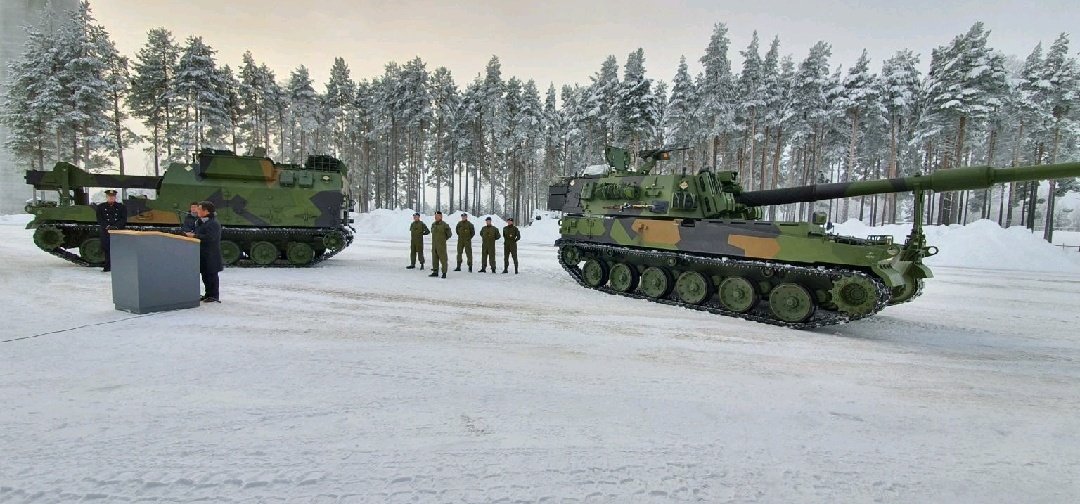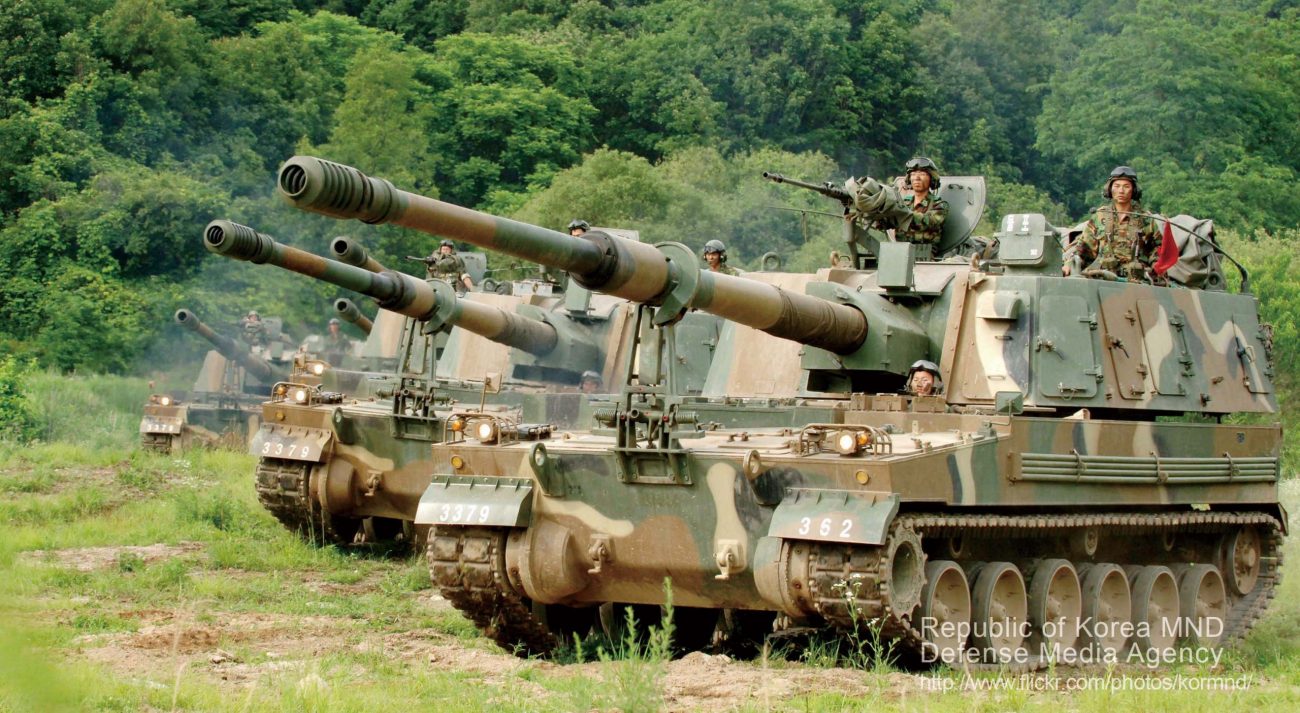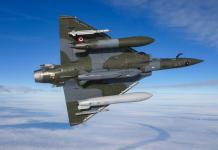After Poland, Finland, and India, Norway has decided to double its fleet of self-propelled artillery. It has placed an order to buy an additional 24 K9 Thunder howitzers from Hanwha Aerospace for 5.65 billion Norwegian kroner (US$534 million).
The Norwegian government announced on April 4 a new proposal to invest approximately 17 billion Norwegian kroner (US$1.60 billion) into rearmament and modernization initiatives for the Norwegian Armed Forces. A central component of this investment is the planned acquisition of 24 additional K9 Thunder 155mm self-propelled howitzers.
“We are facing a serious security situation. We are therefore requesting the Storting [Parliament] to approve significant investments in various parts of the Armed Forces in order to strengthen Norway’s defense capability,” Minister of Defense Tore O. Sandvik said in a statement.
According to the government proposal, these howitzers will form the core of a new artillery battalion within the future Finnmark Brigade, a strategic force to bolster Norway’s defenses in the high north.
“The Labour government proposes to purchase 24 new K9 artillery pieces to be used to build up an artillery battalion in the planned Finnmark Brigade,” the government statement said.
The procurement of 24 additional K9 howitzers marks a continuation and expansion of Norway’s artillery modernization program, which began in December 2017 when Norway signed its first contract with South Korea’s Hanwha Land Systems for purchasing 24 K9 vehicles and 6 K10 ammunition vehicles.

These artillery guns, delivered by 2020, replaced the aging M109A3GN tanks and significantly upgraded the firepower and mobility of the Norwegian Army’s artillery units. The M109 tanks had been in service with the Norwegian military for over 50 years and were later donated to Ukraine.
Subsequently, in 2022, Norway exercised an option in its contract with Hanwha to purchase four additional K9 howitzers and eight K10 vehicles.
Therefore, before the latest order, Norway already had 28 K9 howitzers and 14 K10 vehicles.
Golden Dome Or Golden Mirage? Is Trump Chasing A Dream As Critics Say Golden Dome Is Not Feasible?
The decision to order 24 additional K9 Thunder 155mm self-propelled howitzers shows Norway’s confidence in the platform’s battlefield performance and interoperability with NATO forces.
With the latest purchase, Norway has invested a total of 11.1 billion kroner (US$1.02 billion) in the South Korean artillery system.
Apart from K9 howitzers, the 17 billion Norwegian kroner (US$1.60 billion) defense procurement plan includes purchasing maritime mine countermeasures (MMCM), unmanned surface vehicles (USVs), remotely operated vehicles (ROVs), and autonomous underwater vehicles (AUVs) for the Norwegian Navy.
“We have to make sure that the Armed Forces have the resources needed to detect and neutralize mines and other explosives underwater. It will contribute to safe sailing for our own and allied ships in Norwegian waters and secure critical subsea infrastructure,” Defence Minister Sandvik said.
The latest defense procurements are part of Norway’s broader defense modernization program amid heightened geopolitical tensions in the Baltic region and an indication from Donald Trump’s administration that it is no longer ‘primarily focused’ on Europe’s security.
In October last year, the Norwegian government proposed to raise the country’s 2025 defense budget by 19.2 billion kroner to 110.1 billion kroner (US$10.07 billion).
The Labor government has also outlined plans to increase defense spending by 600 billion kroner (approximately US$54.8 billion) over the next 12 years, up to 2036.
Baltic Countries & K9 Thunders
Notably, Norway is not the only country in the Baltic region that is placing its faith in the South Korean artillery system.
Estonia placed an order for 24 South Korean K9 Thunder 155 mm SPHs from Hanwha Aerospace in 2018. This order was supplemented by a US$ 39.3 million contract signed in January 2023 for 12 more K9s, bringing Estonia’s total requirement to 36 SPHs.
“The war in Ukraine clearly shows the importance of indirect fire weapons. In the light of the lessons learned from Ukraine, we’ve made rapid decisions to equip both of infantry brigades with additional K9 Thunder self-propelled howitzers and to bring Estonia’s indirect fire capability to a whole new level,” the Estonian defense minister, Hanno Pevkur, has said at the time.

In Estonia, these artillery guns replaced the aging Soviet-era D-30 122 mm and 24 FH-70 155 mm towed guns, which were later donated to Ukraine.
The K9 artillery guns delivered to Estonia also participated in NATO’s Steadfast Defender 2024 exercises.
Similarly, Finland began its K9 Thunder procurement program in 2017 when it signed a 146-million-euro (US$159.5 million) agreement with Hanwha to supply 48 K9 howitzers.
Satisfied with their performance, Helsinki ordered 10 additional systems for US$30 million in October 2021.
Following Russia’s full-scale invasion of Ukraine in 2022, Finland ordered 38 additional systems for US$134 million, effectively doubling the initial order of 48 K9 howitzers and bringing the total number of K9 howitzers in the Finnish Army to 96 units.
However, no other country is betting more on the South Korean artillery guns than Poland. In 2022, Poland signed a framework agreement with Hanwha to buy 672 K9 howitzers in two different versions.
In 2022, a US$2.4 billion order for 212 K9A1 Thunder howitzers was placed. Subsequently, in December 2023, Poland ordered 152 additional K9 howitzers (6 K9A1 units + 146 K9PL units) for US$2.6 billion.
The deal also covers training, logistics, technical documentation, and a significant stock of 155mm ammunition (tens of thousands of rounds). Local production in Poland, in collaboration with Polska Grupa Zbrojeniowa (PGZ), is planned to start in 2026 at a new facility.
India Doubles Its K9 Howitzers
Apart from Poland and Finland, India has also doubled its initial order of K9 howitzers.
India initially ordered 100 K9 units in 2017. The deliveries for this initial order were completed by 2021. Subsequently, in April 2025, India ordered 100 additional K9 Vajra-T self-propelled howitzers for the Indian Army.
The Indian Army’s K9 units have performed exceptionally well both in the desert conditions where they were initially deployed and in the high-altitude mountain conditions where they were deployed following tensions with China in the Ladakh sector in June 2020.
The Worldwide Success Of K9 Thunders
The K9 Thunder, developed by the South Korean Company Hanwha Aerospace (formerly Hanwha Land Systems), is a state-of-the-art 155mm/52-caliber tracked self-propelled howitzer. It has firmly established itself as one of the most sought-after military equipment items on the international arms market.
The K9 artillery gun consists of an armored vehicle with a 155 mm cannon that can fire shells to distances of over 40 kilometers and launch projectiles at a speed of around 65 kilometers per hour.
The K9 artillery system can carry up to 48 projectiles and fire shells in MRSI (Multiple Rounds Simultaneous Impact) mode. This mode allows it to launch three shells in under 15 seconds—one every five seconds—each following different trajectories to hit the target simultaneously.

Since its debut in 1999, the K9 has become a cornerstone of South Korea’s defense exports, making up more than half of global self-propelled howitzer orders. As of last year, over 1,400 units of the K9 have been delivered or are slated for export to various countries.
South Korea itself operates a large fleet of K9 howitzers, which are deployed along the heavily fortified demilitarized zone (DMZ) separating it from North Korea.
The K9’s ability to operate in the challenging mountainous terrain of the DMZ is a key feature, as it is equipped with an advanced hydropneumatic suspension that helps it navigate rough landscapes with ease.
The K9’s five-man crew operates in a fully enclosed environment, protected from nuclear, biological, and chemical threats, with 19mm steel armor providing defense against heavy machine-gun rounds and shrapnel.
Additionally, a .50 caliber machine gun mounted on the turret offers close defense and limited air defense capabilities.
One of Hanwha’s key advantages is its ability to assemble a K9 in approximately 180 days, two to three times faster than its competitors. Additionally, the howitzer is cost-effective, with a unit price of around US$3.5 million, making it significantly cheaper than comparable Western alternatives.
The K9 Thunder is widely adopted around the world, with deliveries either completed or in progress to countries including Australia, Egypt, Estonia, Finland, India, Norway, Poland, Romania, and Turkey.
- Sumit Ahlawat has over a decade of experience in news media. He has worked with Press Trust of India, Times Now, Zee News, Economic Times, and Microsoft News. He holds a Master’s Degree in International Media and Modern History from The University of Sheffield, UK.
- He can be reached at ahlawat.sumit85 (at) gmail.com




